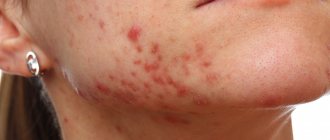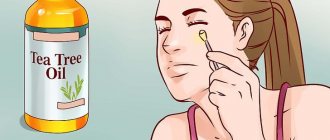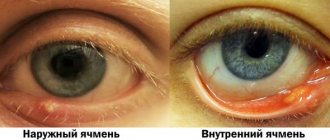Etiology and pathogenesis
The most common cause of enlarged pores on the face is sagging skin due to aging. As the main proteins of connective tissue - collagen and elastin - degrade with age, the skin begins to sag, and the pores gradually increase in diameter and become noticeable.
Pores may expand due to excess sebum associated with increased sebum production . Sebum accumulates in the pores along with horny scales and dirt particles, causing them to swell and become visible. Often this condition is accompanied by acne. It is significantly aggravated by the abundant use of decorative cosmetics , which “clog” the pores and contribute to their expansion.
The presence of enlarged pores on the face is associated with gender : men, on average, have larger pores compared to women. However, reaching puberty, menstruation, pregnancy and hormonal fluctuations have a significant impact on the size of pores, which is why they can appear in women.
In addition to gender characteristics, enlarged skin pores are inherited . If these skin changes are present in close relatives, one should expect the appearance of a similar problem in children.
Photodamage plays a certain role in this pathology . Excess solar radiation disrupts the functioning of mitochondria, causing a decrease in their ability to capture oxygen and synthesize ATP, which inhibits cell migration and division. Ultraviolet light changes the expression of transforming growth factor β (TGF-β), which is a major regulator of the activity of matrix metalloproteinases that are involved in collagen remodeling. Ultraviolet light also stimulates the release of cytokines that suppress the immune response, disrupts the structure of elastin fibers, reduces the density of the microfibrillar network in the area of the dermal-epidermal junction, and increases the activity of proteolytic enzymes. All this leads to multiple changes in the skin and, in particular, to the appearance of enlarged pores.
One of the reasons for the appearance of enlarged pores on the skin of the face may be the frequent and repeated use of chemical peels, accompanied by an inflammatory reaction: a paradoxical phenomenon, given that peels are used to reduce enlarged pores. In this case, the aesthetic defect even has a special name - “ peeled skin ”.
Sebum - what is it?
Sebum
is a secret consisting of natural esters and fatty acids secreted by the sebaceous glands of the skin. Its main task is to maintain the integrity of the protective hydrolipidic mantle of the epidermis. Simply put, sebum acts as a natural lubricant for the skin.
The most overactive sebaceous glands are in seborrheic areas: the face, upper chest and back. On average, the sebaceous ducts of an adult produce up to 20 g of sebum per day. If for some reason the glands synthesize more sebum than required, a characteristic oily sheen appears on the surface of the facial skin.
Functions of sebum
In addition to the troubles in the form of signs of acne, which are provoked by excess sebum, the secretion also has a number of important functions:
- Natural skin hydration, preventing moisture evaporation from the surface of the epidermis and preventing dryness, dehydration and early skin aging.
- Protection from the negative effects of external factors, such as dust and ultraviolet radiation - sebum acts as a natural antioxidant.
- Antimicrobial protection against pathogenic microflora and maintenance of normal skin microbiome.
- Responsible for the pH balance of the skin.
- Participates in the skin thermoregulation system.
Composition of sebum
Sebum consists of a mixture of various lipids and by its nature cannot harm the skin. The composition of sebum depends on age, gender, lifestyle and genetic characteristics of the body - hormonal levels and the state of the central nervous system and ANS (central and autonomic nervous system). Normally, the secret contains the following components:
- triglycerides (41%);
- wax esters/wax esters (26%);
- squalene (12%);
- fatty acid;
- cholesterol;
- phospholipids;
- glycerol.
Clinical manifestations
Enlarged pores on the face appear as visible round or irregular crater-shaped depressions on the skin ( Fig. 1 ). Their number on the cheeks varies on average from 10 to 90 pcs/cm2. In the literature, the facial topography with enlarged pores is sometimes compared to the surface of a golf ball ( Fig. 2 ).
There are very few studies on this topic, but there is data on the density of enlarged pores among various ethnic groups, obtained from a survey of more than 2,500 women aged 18–80 years from various countries around the world ( Table 1 ).
Table 1. Average number of enlarged pores per square centimeter of skin depending on the ethnicity and age of women (Flament F., Francois G., Qiu H., et al. Facial skin pores: a multiethnic study. Clin Cosmet Investig Dermatol 2015; 8: 85–93)
| Ethnic group | 18–29 years old | 30–39 years old | 40–49 years old | 50–59 years old | 60–69 years old | >70 years |
| Europeans | 63,96 | 62,22 | 64,49 | 59,93 | 61,13 | – |
| Brazilians | 91,26 | 81,75 | 68,7 | 61,73 | – | – |
| Indians | 82,68 | 79,91 | 77,12 | 77,53 | 73,56 | 71,19 |
| Chinese | 21,13 | 23,24 | 20,77 | 24,51 | 20,20 | 21,66 |
| Japanese | 67,41 | 69,64 | 69,78 | 72,44 | 69,75 | 68,83 |
As you can see, the skin of women living in China has the fewest enlarged pores, while women living in Brazil have the most enlarged pores. Women in European countries occupy an intermediate position. You can also notice a tendency for the number of enlarged pores to decrease with age.
Rice . 1. Enlarged pores on the face (American Academy of Dermatology, AAD)
Rice. 2. Skin with enlarged pores resembles the surface of a golf ball.
Consequences of excess sebum secretion
In addition to the obvious consequences in the form of rashes, excessive sebum production entails the following consequences:
- The skin of the face and body becomes shiny, looks unkempt, porous, gets dirty faster, and the image loses its freshness. Some time after the last cleansing of the skin, the oily sheen appears again. By neglecting or, conversely, being too carried away with cleansing, those with oily skin types risk experiencing signs of acne or dehydration of the skin.
- The scalp may also react to increased sebum production: signs of dandruff – oily seborrhea – appear. Against the background of changes in the functioning of the sebaceous glands, too much sebum is produced. At the same time, the skin of the scalp quickly becomes oily, undergoes inflammatory processes and flakes off.
Principles of treating enlarged pores on the face
General recommendations for caring for skin with enlarged pores:
- Wash your face with warm, but not hot water. High water temperatures can irritate the skin, causing pores to become larger in diameter.
- When washing, touch your face as gently as possible. Excessive friction irritates the skin and provokes inflammation, which makes pores more noticeable.
- For skin care, you should choose mild and non-comedogenic cosmetics.
It has been found that after 15–30 days of use, 6% green tea extract noticeably evens out the microrelief of facial skin - it becomes smoother, and the pores become narrower. An objective increase in skin elasticity and firmness was also recorded.
Black willow bark contains tannins, some of which are almost identical to those found in green tea. They have an antiseptic, protective effect in the treatment of enlarged pores and help narrow pores, including on aging skin.
Bitter cucumbers contain cucurbitin (3-aminopyrrolidine-3-carboxylic acid), a substance of the triterpene class, which, in combination with aromatic aldehydes, tightens pores and smoothes the skin.
Growth factors help restore damaged blood vessels, reduce skin dryness, narrow pores and even out complexion. The most popular is epidermal growth factor (EGF) , which stimulates the growth and division of epidermal cells. At the same time, there is also an increase in the synthesis of DNA, RNA, hyaluronic acid, collagen and elastin - as a result, the appearance of aging skin improves, and pores narrow.
Enlarged pores can be treated with retinoids . They affect the proliferation and differentiation of basal keratinocytes, accelerating the renewal of the epidermis. This helps cleanse the skin, narrow the pore diameter and reduce excess sebum production.
Another method of treating enlarged pores is physical and chemical peels . For example, chemical peels tighten pores, strengthen skin barrier functions and reduce TEWL, inhibit oxidative stress and neurogenic inflammation, promote oxygenation, and have a bactericidal and sebum-regulating effect. However, it is important not to overdo it, so as not to get “peeled skin”.
A variety of hardware techniques can be effective in treating enlarged pores. On the one hand, these are purely “therapeutic” approaches that normalize the function of the sebaceous glands and the proliferation of epidermal cells, which ultimately leads to an aesthetic effect in the form of a reduction in pore size. These include RF therapy, non-invasive carboxytherapy (genO+ device), as well as techniques whose action is based on heating the dermis, for example, M22-IPL.
Another group of hardware methods for treating enlarged pores combines fractional lasers: they are used to remodel the dermis and smooth the surface of the skin. Lasers such as Clear+Brilliant, Fraxel and M22-ResurFX have been clinically proven to reduce pore size.
The main causes of sebum production disorders
Alexander Prokofiev, a dermatovenereologist and expert of the La Roche-Posay brand, talks about the possible causes of impaired sebum synthesis.
When sebum production increases
- Peak activity of the sebaceous glands occurs during puberty and can last up to 25 years. This is due to hormonal changes in the body. Increased sebum production occurs during pregnancy, certain diseases (endocrine system, liver disease, gastrointestinal imbalance), as well as stress and lack of sleep, as a result of which the body releases the stress hormone cortisol.
- An unbalanced diet, consumption of fatty, salty, or smoked foods, lack of nutrients and fiber stimulate sebum production.
- Lack of cleansing or over-cleansing, overuse of products containing alcohol, as well as certain ingredients in skincare products can all cause clogged pores.
- Often people with signs of a problematic skin type try to cope with excess oiliness on their own and overdo it with mattifying products, thereby drying out the skin. In response to dehydration, the epidermis reacts by releasing a natural moisturizer - sebum, and the face shines even more.
When there is too little sebum
Lack of sebum is the other side of the coin, which in its own way aggravates the condition of the epidermis: dryness, a feeling of tightness, irritation, and peeling appear. Due to a deficiency of lipid-containing secretions, the protective mantle becomes thinner, the epidermis is subject to increased susceptibility to external aggressors, and begins to rapidly lose moisture, elasticity and density. Dry skin is the main reason for the appearance of the first age-related skin changes: wrinkles, decreased turgor.
When sebum is thick
Thick sebaceous secretion is the cause of enlarged pores, comedones and acne. Sebum literally bursts the sebaceous ducts from the inside, forming a sebaceous plug and clogging the pores. Upon contact with oxygen and light, the secretion acquires a characteristic black or dark gray color - this is how sebaceous threads are formed - the well-known black dots.
Sebaceous threads on the nose. Differences between blackheads and sebaceous threads
- Magazine pictures show models' perfect skin on their noses and cheeks, but underneath the makeup and photographic manipulation, they probably have the same blemishes in the fatty parts of their faces as other people. You may confuse these small undulations with blackheads, but they are probably not deformities, but natural sebaceous filaments.
Small black spots on your nose are probably sebaceous threads, not blackheads (BananaStock / BananaStock / Getty Images)
hard fat
Your skin contains thousands of tiny glands that produce an oily, waxy material called sebum. If you have oil problems, your sebaceous glands are responsible. Overactive glands occur due to a genetic predisposition to oily skin due to hormonal activity. Under normal conditions they keep the skin hydrated and elastic, but when clogged they can become reservoirs for infectious bacteria.
carnations
Sebum, which stores and strengthens inside the pores, forms a clove. In addition to sebum, cloves are also made up of dead skin cells. Naturally whitish sebum turns brown or black when it oxidizes, giving cloves its characteristic dark color. If the dermatologist tightens the skin clove, you may see the secretion have a dark top in the part that is exposed to air. Don't try to remove blackheads from your skin alone; You may get scars.
Sebaceous threads
If you look more closely at the tip of your nose, you may notice small spots that look like blackheads. Although these marks also have the tips of columnar structures that fill the pores, they are not products of infection. They are sebaceous filaments, natural hair formations that bind the flow of sebum through the pores in which they are found. Dr. David A. Whiting described them in his study for the Western Journal of Medicine as "a porous mass released from wild debris." Although it doesn't look attractive, it is a natural phenomenon found in almost all skin types.
Differences between blackheads and sebaceous threads
A clove is a single rash on the skin, while sebaceous filaments form a uniform and random pattern on an oily area of skin such as the nose or chin. Carnations tend to be larger and darker; Sebaceous threads have a beige or grayish tint, rather than the charcoal color of cloves. The threads usually feel lighter to the touch, unlike a large stud which may have a raised edge around the pore. Cloves can accompany pimples, which indicate acne. Sebaceous filaments are found in all adult noses and have nothing to do with acne.
Treatment of acne on oily skin with Clindovit® gel
Gel Klindovit® for acne has an antibacterial effect. It contains clindamycin phosphate, which is an antibiotic with antimicrobial activity against a large number of strains of P. acne. It reduces the rate of protein synthesis in bacterial cells and reduces the amount of free fatty acids on the surface of the epidermis. 6, 18
Klindovit® acne gel must be taken 2-3 times a day 6. Its base also includes components that moisturize the skin (emollient) and accelerate regeneration processes (allantoin). 6
The course of treatment for oily facial skin with acne with Clindovit® gel is about 6-8 weeks. If necessary, therapy can last up to 6 months. 6
Sebum control: how to remove excess sebum
Home corrective care based on mattifying formulas that absorb sebum will help control excess sebaceous secretions. In cosmetics for oily problem skin, look for mattifying, moisturizing and restoring components, hydroacids, hydrofixatives, amino acids and antioxidants.
Important: If, after self-care, oily shine and imperfections do not go away, consult a dermatologist. The specialist will prescribe tests, based on the results of which he will adjust your individual sebum removal system.
Alexander Prokofiev, dermatovenereologist, La Roche-Posay brand expert, tells what proper care for oily skin should be to control sebum:
- Any beauty routine begins with regular cleansing. Oily skin requires special attention. Choose non-comedogenic formulas with a mattifying effect.
- Exfoliate the stratum corneum regularly - dead cells mix with sebum and clog pores. Use gentle skin renewal products (scrubs, peelings, gomages) based on exfoliating ingredients, such as AHA, LHA and salicylic acids, 1-2 times a week.
- Products containing different types of clays and their derivatives have an additional cleansing and mattifying effect. For example, Masks absorb excess sebum well, attracting various impurities, thereby cleansing and ridding the skin of blackheads. Apply the mask 1-2 times a week, the next step after intensive cleansing.
- Finish cleansing your skin by applying a mattifying lotion or toner. Give preference to products that do not dry out the skin. The lotion will also prepare the skin for basic care.
- Basic corrective care should be aimed at additional regulation of skin oiliness, have protective, restorative properties and maintain skin hydration, preventing transepidermal moisture loss. As part of corrective care, pay attention to hygroscopic components, such as glycerin and hyaluronic acid.
- Use Sanskrin - UVA and UVB rays disrupt the protective barrier of the epidermis, provoke active sebum production and discomfort.









